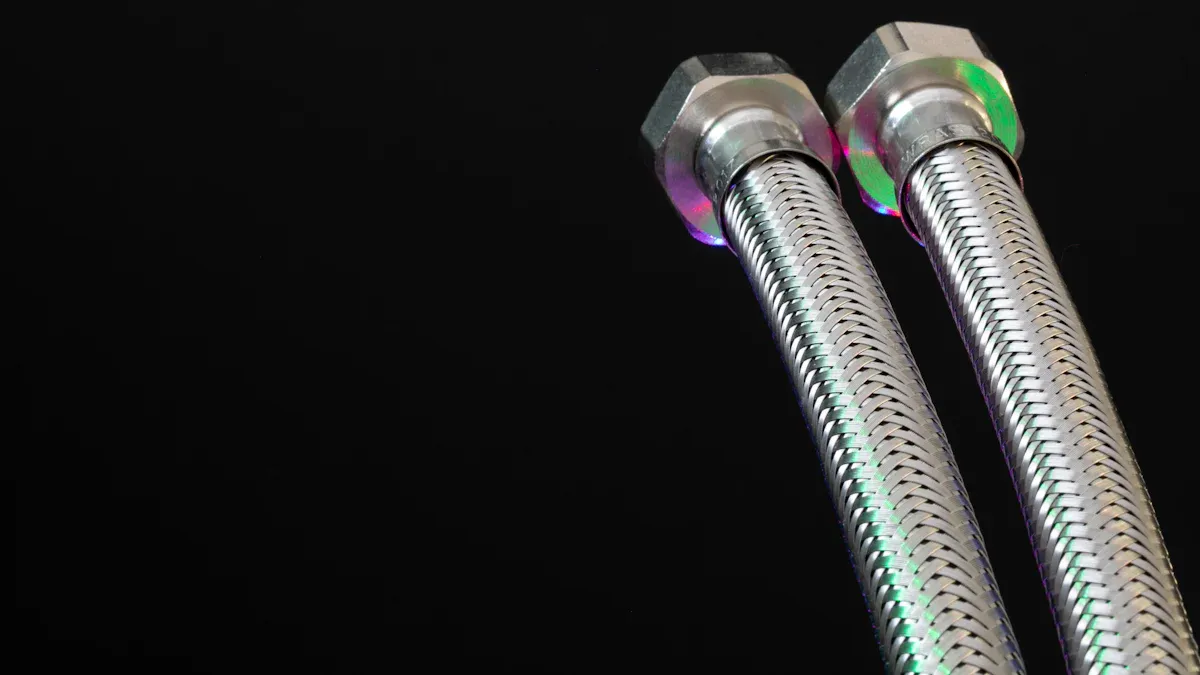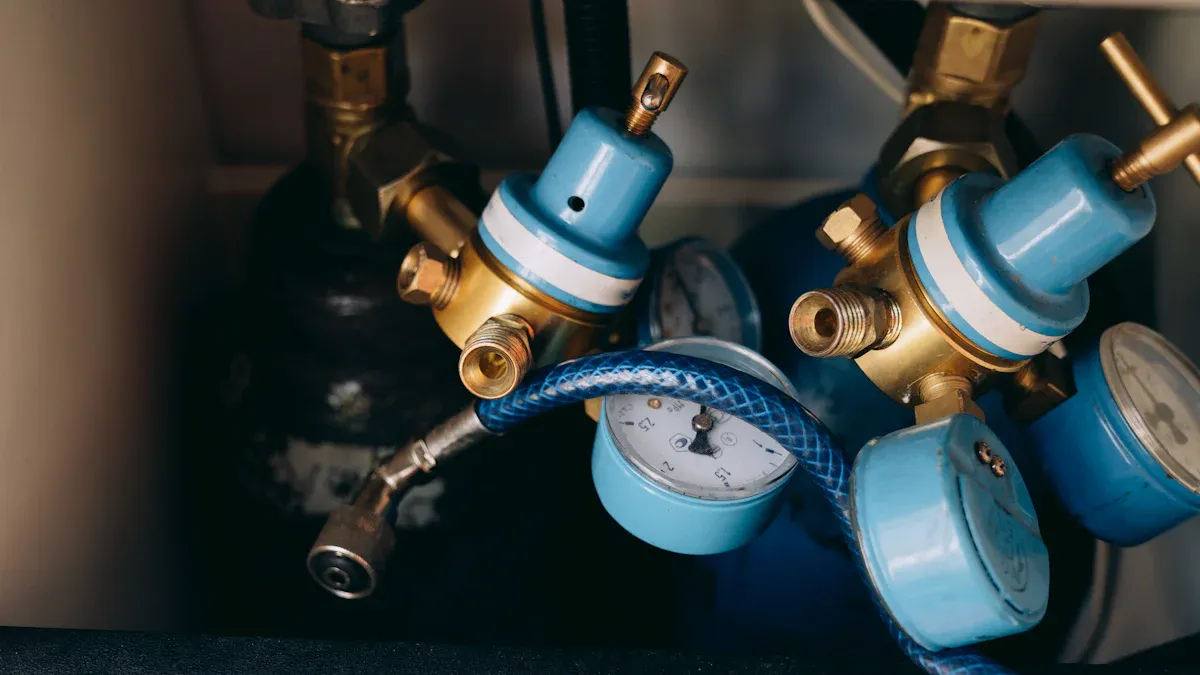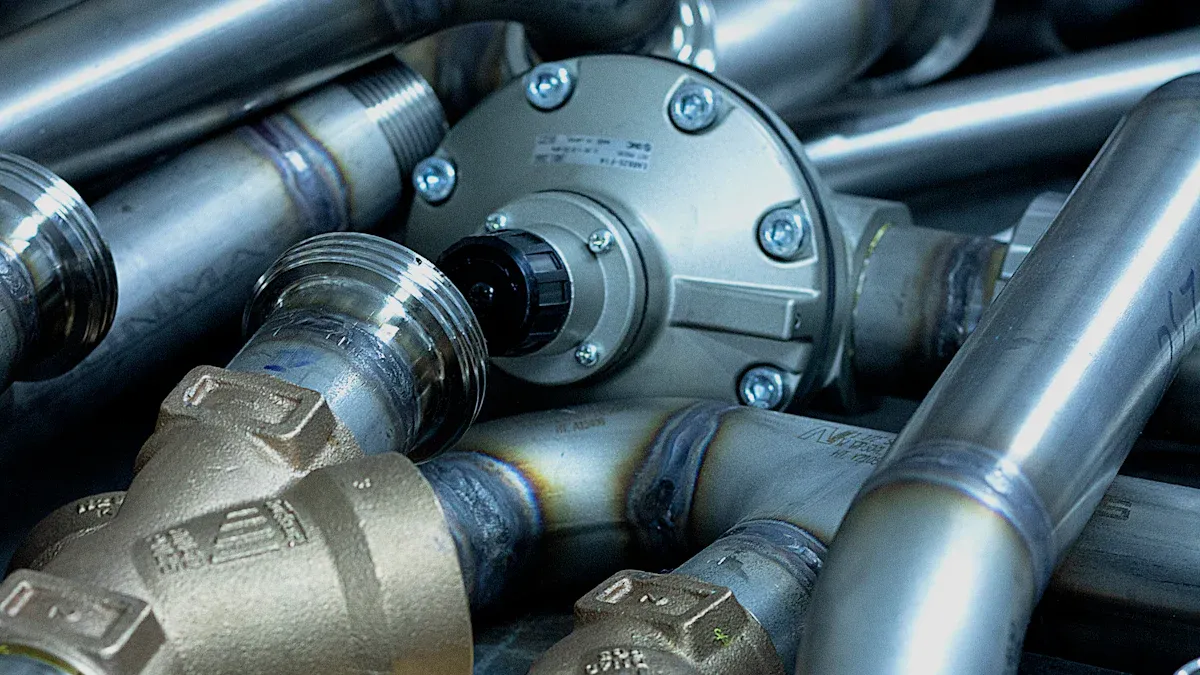Hose Fittings

Choosing the right hose fittings matters for every industry. They keep equipment running and help avoid leaks or costly downtime.
- Proper hydraulic fittings stop bursts and improve safety.
- Stainless steel fittings stand up to harsh environments.
- Parker hose fittings offer reliable performance.
- Correct hydraulic fitting selection extends equipment life.
Key Takeaways
- Choose hose fittings that match your industry needs by considering fitting types, materials, and pressure ratings to ensure safety and long equipment life.
- Use materials and fittings designed for your environment to prevent leaks, resist wear, and handle heat, chemicals, or moisture effectively.
- Always check standards, supplier quality, and proper assembly methods to avoid costly breakdowns and keep your systems running smoothly.
Key Considerations for Hose Fittings Selection

Fitting Types and Applications
Choosing the right fitting type can make a big difference in how well a system works. Each type fits certain jobs and industries. For example, thrust-wire fittings have tough surfaces that handle high torque and vibration. These work well in construction, agriculture, oil and gas, and mining. Banjo fittings help in low-pressure systems and let hoses move without twisting. You might see them in brake systems or power steering. JIC fittings are strong and cost-effective, handling up to 5,000 psi. They are common in industrial and agricultural equipment.
Some industries need special fittings. In aerospace, ORB fittings keep hydraulic systems safe under high pressure. Marine workers use them for steering systems because they resist corrosion. Industrial hydraulics rely on them for leak-free, high-pressure connections. Oil and gas companies pick them for their strength against pressure and harsh materials.
Tip: Matching the fitting type to the job helps prevent leaks, boosts safety, and keeps equipment running longer.
Here’s a quick look at how different fitting types perform:
| Fitting Type | Key Features & Design | Pressure Range | Best Use Cases |
|---|---|---|---|
| Thrust-wire | Hardened, resists vibration | High | Construction, mining, oil & gas |
| Banjo | Allows hose movement | Low | Brakes, steering, emissions |
| JIC | Leak-resistant, durable | Up to 5,000 psi | Industrial, agriculture |
| ORB | Reliable under pressure | High | Aerospace, marine, hydraulics |
Material Compatibility and Environmental Factors
The material of a hose fitting matters just as much as its type. Heat, chemicals, sunlight, and even dirt can wear out fittings fast. Some materials last longer in tough places. For example, advanced elastomers like HNBR, FKM/Viton, EPDM, and TPU stand up to heat, chemicals, and abrasion. Reinforced hoses with steel wire or Kevlar fibers resist bending and breaking.
Manufacturers add special chemicals to hose compounds to fight aging. This keeps seals tight and pressure ratings high. If a fitting’s material does not match the fluid or environment, it can fail early. Stainless steel and brass work well in places with lots of moisture or chemicals. High-temperature alloys handle heat better.
- Hydraulic hose life drops with too much heat, chemical exposure, or UV rays.
- The wrong material can cause leaks, loss of flexibility, or even sudden failure.
- Good material choices and engineering help hoses and fittings last longer, even in harsh conditions.
Pressure, Temperature, and Size Ratings
Every hose fitting must handle the right pressure, temperature, and size. If not, the system could break down or become unsafe. Pressure ratings come from strict tests. These include burst tests, impulse tests, proof tests, and vacuum tests. Manufacturers also check how fittings perform in hot, cold, or corrosive places.
| Aspect | Details |
|---|---|
| Standards Referenced | BS 143 & 1256:1986 set pressure and temperature ranges for fittings |
| Pressure Ratings | Malleable iron: up to 100 bar (small sizes), 64 bar (larger sizes); burst tests often exceed these |
| Temperature Limits | Galvanized fittings: not below -10°C (14°F); unions: up to 208°C or 230°C |
| Size Impact | Larger fittings may have lower pressure ratings; burst tests show size matters |
| Testing Types | Production and type testing per BS EN 10242, BS 143 & 1256, ISO 49 |
- Extreme temperatures or corrosion can lower a fitting’s pressure rating.
- Size and material both affect how much pressure a fitting can handle.
- Following manufacturer specs and industry standards keeps systems safe.
Note: Always check the pressure, temperature, and size ratings before choosing hose fittings. This step helps avoid costly breakdowns.
Connection Types and Assembly Methods
How a hose fitting connects and gets assembled affects its strength and how easy it is to use. Some fittings, like ball and sleeve types, let users connect and disconnect hoses quickly. Barbed fittings work best for low-pressure jobs. Cam-lock fittings lock in place for heavy-duty uses. Crimp fittings need special tools but create a strong, permanent seal. Compression fittings use nuts and ferrules to grip tubing, while flare fittings use a flared end for a deep seal.
- Crimp, compression, flare, and cam-lock connections all have their own strengths.
- SAE and ISO standards help make sure fittings match and work well together.
- Good installation practices—like using the right tools and following torque specs—keep connections safe and long-lasting.
- Specialty connections, such as quick-disconnects, make maintenance easier in some systems.
Regular checks and proper assembly help hose fittings last longer and work better. Picking the right connection type and assembly method means fewer leaks and less downtime.
Meeting Industry Needs with Hose Fittings

Industry-Specific Requirements and Standards
Every industry has its own set of rules and needs when it comes to hose fittings. For example, manufacturing, chemical processing, oil and gas, automotive, aerospace, and healthcare all use hose connectors in different ways. Some jobs need fittings that can handle high pressure or harsh chemicals. Others need fittings that resist corrosion or work in extreme temperatures.
- Stainless steel threaded pipe fittings work well in chemical plants and offshore oil rigs because they fight rust and heat.
- Carbon steel fittings offer strength for power plants.
- Copper, brass, and plastics help in plumbing, HVAC, and water systems.
Many industries follow standards like ISO 7241A, ISO 16028, and SAE J517. These standards make sure hose fittings work safely and fit with other parts. Companies often choose fittings that meet or beat these rules.
Custom and Specialized Hose Fittings
Some jobs need more than standard parts. Custom and specialized hose fittings help in complex places like oil and gas fields, construction sites, and factories. These fittings last longer and fit better, which means fewer leaks and less time fixing things.
Reusable hydraulic hose fittings let workers make quick repairs on-site. This saves time and money. Custom fittings also help companies meet strict safety and environmental rules. They can handle tough jobs and keep systems running smoothly.
Ensuring Quality and Supplier Reliability
Getting quality hose fittings depends on picking the right supplier. Reliable suppliers deliver parts that match the specs and pass strict tests. They use strong quality checks and keep good records.
- Good suppliers help lower costs by avoiding rework and safety problems.
- They plan ahead to avoid supply delays.
- Many have ISO 9001 or other quality certificates.
Building trust with a supplier means fewer risks and better results. Companies that check their suppliers often get safer and more reliable hose fittings.
Choosing the right hose fittings keeps systems safe and efficient. Safety, compatibility, and long-term value matter most. A checklist helps: review requirements, check supplier certifications, test samples, and confirm standards. This step-by-step approach reduces risks and ensures the best fit for every application.
FAQ
What is the most common mistake when choosing hose fittings?
Many people pick the wrong material or size. This can cause leaks or damage. Always check the system’s needs before buying.
Tip: Double-check pressure and temperature ratings for safety.
How often should someone inspect hose fittings?
He or she should check fittings every few months. Look for cracks, leaks, or rust. Early checks help prevent bigger problems.
Can you reuse hose fittings?
Some fittings, like reusable hydraulic types, work again after cleaning. Most crimped fittings do not. Always follow the manufacturer’s advice.
| Fitting Type | Reusable? |
|---|---|
| Crimped | No |
| Reusable Hydraulic | Yes |
Post time: Jul-07-2025
